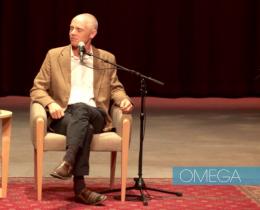Everyone is the Buddha. Everyone has the perfect body. If you weren't able to compare your body to any other, what could possibly be lacking? Without the mind’s comparison, no one can be too fat or too thin. That's not possible; it's a myth. Comparison keeps you from the awareness of what is. You could weigh 500 pounds, you could be dying of cancer, and still you would have the perfect body, the one that you need in order to be exactly who you are in this moment.
People sometimes use The Work with the motive of healing their bodies. They don't understand that sanity is the cure, and that's not up to the body. Ultimately the body’s not going to make it. This is very good news. It’s over, forget it, let’s work with cause.
If this body story were true, it would mean that no fat person could ever be self-realized, no one in a wheelchair, no one old or sick, no one who’s not beautiful. That would leave out practically the whole human race! Under this theory, none of us would have a chance for freedom. People think they need to get their life perfect first, and then they’ll have peace. Can we just do it from here, now?
Heal the Mind, the Body Will Follow
I suggest that you not do The Work with the motive of healing your body. Go for the love of truth. Heal your mind. Meet your stressful thoughts with understanding. You may spend years eating the right food, exercising every day, and getting your body into optimal shape, and then a truck hits you in the crosswalk. Can you be happy right now?—not tomorrow, not in 10 minutes? I use the word happy to mean the natural state of peace and clarity. That’s what The Work gives us.
Bodies don’t crave, don’t want, don’t know, don’t care, don’t love, don’t hate, don’t get hungry or thirsty. The body only reflects what the mind attaches to. There are no physical addictions, only mental ones. Body follows mind; it doesn’t have a choice. (Actually it all happens simultaneously, but as long as we seem to be living in a world of duality, let’s say that body follows mind.)
When the mind is at peace, it projects the body as perfect, even on its way to the hospital in an ambulance, in the midst of a heart attack. There’s no fear of anything that may happen. Fear isn’t possible for the sane mind. It loves every moment of what might be its last trip identified as this or that, in an ambulance or alone. It’s no longer at war with reality.
It’s Not Personal
One day in 1986, I was sitting on the couch, and when I tried to get up, I couldn’t move. My legs were paralyzed. It was as if they had nothing to do with me. I remember putting my hands on them and talking to them as I would too dear old friends. “Oh Sweethearts,” I said, “You’ve carried me for so many years without any demands. You don’t ever have to move for me again. Not ever.”
I felt an inexpressible gratitude that they had brought me that far. And I just sat there with them and waited, without any expectations, to see what they would do. About 45 minutes later, they came back to life at a level that I had never experienced before. They seemed to have more strength and vitality than they’d had even when I was a child. It was as if they had just been born into a new life—as if love was so attractive that they would move beyond themselves to join it.
The clear mind understands that the body is not personal. It can’t cause any problems; mind’s identification with the body is what causes the confusion and suffering. Identified mind fears bodilessness. It doesn’t know how to be homeless, selfless, apparently lost forever. It isn’t realized enough to let go, and when it has a rare moment of no identification, it scares itself small again and doesn’t know how to regain its freedom.
We Already Know How to Die—and Live
The Work is one way the mind can lose its grip safely as it awakens to reality. Mind is limited when it thinks that the body it identifies as is less than perfect. It sees the body and realizes that it’s dying, and it panics over its thoughts of what it would be without any identification at all. It doesn’t realize that the identification was false to begin with. How can mind be body? How can it live or die? As long as it thinks it is capable of living or dying, it’s stuck in an illusion.
People are afraid to die. They think they don’t know how. But the truth is that everyone knows how to die. We do it perfectly every night of our lives. When you’re exhausted, and for all you know you’re never going to see daylight again, would you rather go to sleep or stay awake? No contest. We take ourselves to that obliteration every night. And without sleep, we don’t feel right; we may even go crazy from sleep deprivation. What do we wake up to? Mind. Mind wakes up to mind. If we love what we think, we love sleeping (the nothing) as much as we love waking (the something).
To identify as a body, as a “you,” is such a delusional state of mind that with it comes arrogance. If mind believes that it is what it’s not, then it has to imagine that everything it projects is real. And in that arrogance, it thinks it has to preserve what can never be preserved. If mind had a choice, why would it identify as a body and live under the threat of death? Wouldn’t it want to understand how without any identification it is apparently resurrected in the joy of its own bodiless, infinite being?
Even a Heart Attack Can Be Exciting
My heart, for example, is always perfect, because I never believe that it’s mine. Whether it’s beating strongly or blasting into oblivion, it’s as it should be. Even if it were having an attack, it would be perfect for that moment. If you argue with what’s happening when you’re having a heart attack, you’ll have it with a lot of fear. But without a story, you can experience a heart attack in peace. A heart attack can even be exciting.
It’s 1999, and I’m driving home to 35th Street in Manhattan Beach from Peet’s Coffee. The radio is playing music I love, and as I listen, a pain shoots through my chest and arms. It’s excruciating and thrilling at the same time. I’m fascinated.
The traffic is heavy. I look for a parking place, then pull over. I see everything in slow motion: the sky, the trees, the buildings, my hands on the wheel. It’s a beautiful day.
Is this how she dies? Is this the end of the story? I don’t want to miss any of it—not one moment of what could be the final scene. Sky, buildings, asphalt, hands, wheel, silence. What grace!
And as the joy continues to fill me, the pain begins to subside. It goes back to where it came from, and I laughed out loud at the way of it. It’s as good that the story continues as that it ends. I love being present enough not to miss one moment, one breath, of this beautiful apparent life.



